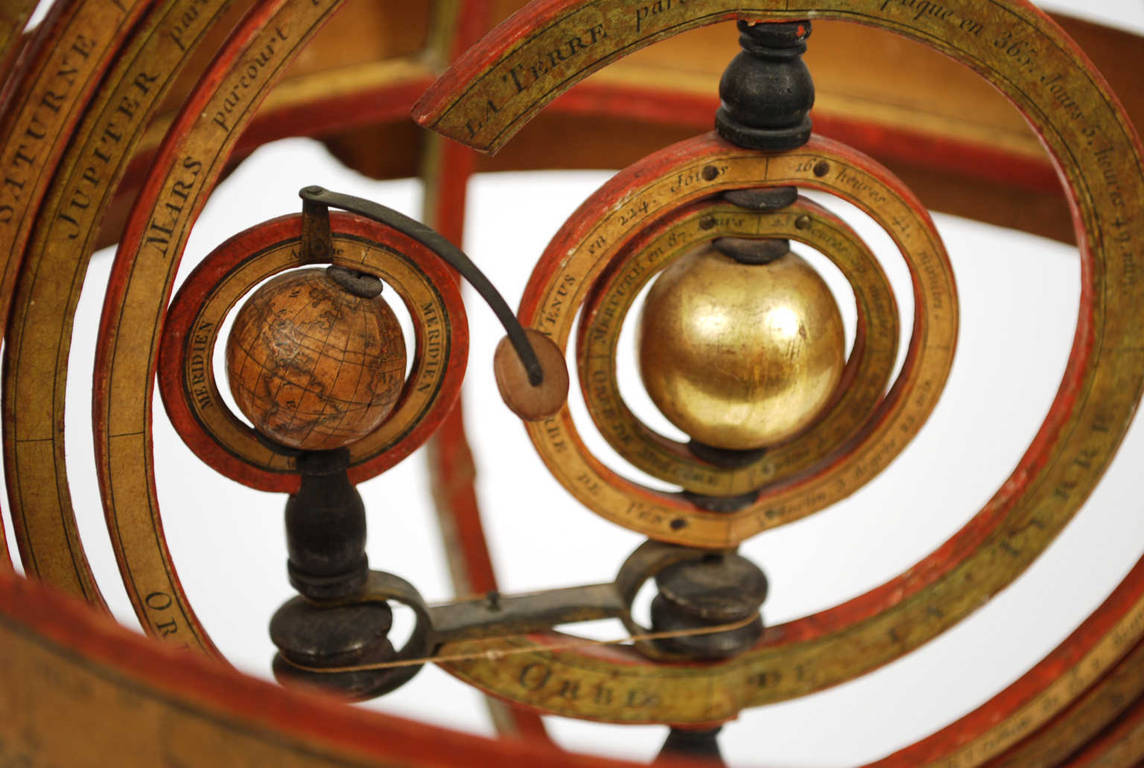1749909317Code 712 Mechanical TelluriumTellurium or mechanical model representing and demonstrating the solar system composed of the Sun, Mercury, Venus, Earth, Moon and Mars, made by the Prague geographer and cartographer Jan Felkl around the second half of the 19th century, the most important and famous manufacturer of globes and astronomical instruments of the Austro-Hungarian Empire at an international level.
On the cartouche of the globe it is written: Obraz Zemekoule Vydal J. Felkl a syn Roztoky u Prahy.
Structure in patinated cast iron bronze and brass, brass gears, wooden planets and papier-mâché globe.
Good condition, fully functional.
Measurements cm 81x20x50 – inches 32x7.9x19.6
It is an ancient astronomical instrument made up of clockwork mechanisms, which allows you to observe from the outside, by turning a crank placed under the gear of the Sun, the motion that the Moon and the Earth, Mercury, Venus and Mars perform within the Solar system.
Mercury completes its rotation around the Sun in 88 days; Venus in 225 days; the Earth in 365 days and Mars in 780 days.
With the affirmation of the heliocentric system theorized by Copernicus, it was possible to build simplified mechanical models of the entire known Universe, with the Earth moving on itself, while the Moon revolved around the Earth and with it around the Sun, together with all the other planets.
In relation to the doctrine that the Universe moves like a gigantic clock mechanism, the mechanical planetarium is able to represent this theory.
The complex system of gears of a mechanical planetarium ensures that the planets rotate around the Sun according to their exact relative motion.
Planetariums of this type were used for educational purposes by private tutors in the service of noble families throughout Europe, who entrusted them with the education of their heirs.
The mechanical planetarium is the most complex and articulated form of representation of the cosmos and represents, in addition to the movement of the Earth, also that of the moon and the planets, almost as if it were a gigantic clock mechanism.
One of the oldest of these devices was the work of Archimedes, of whom Cicero speaks extensively in Tusculanae disputationes I, 63: when Roman troops sacked Syracuse in 212 BC, the consul Marcus Claudius Marcellus brought Archimedes' instrument to Rome, which, thanks to his skill and to "a divine intelligence" that he possessed, had managed to generate the motions of the planets, so different from each other, starting from a single rotation.
Jan Felkl (1817-1878) was born in Bohemia and already in 1840 made illustrated prospectuses for globes in 6 different sizes. Over the next twenty years, it grew to become the largest globe manufacturer on the Austro-Hungarian market, producing terrestrial and celestial globes, in 17 different languages, as well as lunar, planetary and tellurian globes.
Felkl presented his globes at the 1867 World Exhibition in Paris and in 1873 in Vienna.
The first globes were produced by engraving and hand-coloring the segments.
Felkl founded his own Geographical and Lithographic Institute in Prague to produce globes and maps.
In 1870 Felkl moved the factory from Prague to Roztok and took his youngest son as a partner in his company renamed Felkl & Son, producing globes for export, throughout Europe and also to the United States. The business grew to employ more than 40 people, also opening a branch in Vienna. The main customers were: schools, public institutions and libraries.
After the death of Jan Felkl the business was continued by the family until the early 1900s.






























